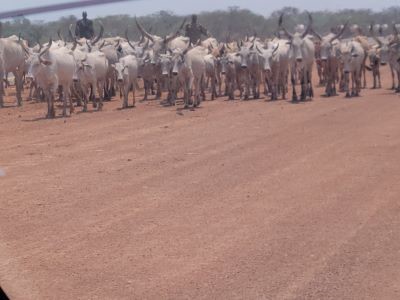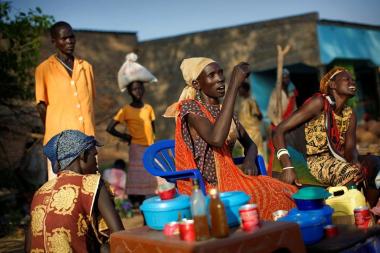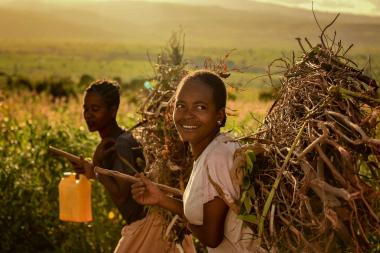Blog
Cattle huts in Jonglei, South Sudan: a key cultural feature for Dinka pastoralists
In this blog, we share how our research with Dinka pastoralists in South Sudan is deepening our understanding of ways to build gender-responsive climate resilient communities.
Publisher SPARC
Cattle have both economic and social significance for pastoralists. So it is not surprising that their place in a homestead is front and centre in Dinka culture, in South Sudan, where it is believed there are more livestock than people. "In South Sudan cattle are like money in a bank," a retired government officer, in Bor, Jonglei State, told us.

During our fieldwork, we wanted to carry out research on ways to support sustainable livelihoods in Dinka communities in Kolnyang Payam, in Bor, Jonglei State. During this time, we saw firsthand how important cattle are to the Dinka. Communities build cattle huts – or Luak as they are known in Dinka – in homesteads to secure livestock. Luak symbolise how men, women, boys, and girls from the community can work together to secure their livelihoods.
Research findings having resonance
Working with the Dinka has shown us the value in using seemingly ‘basic’ structures like Luak that people can speak about as a way into conversations about research, and to ensure we communicate our research findings using language and symbols the community is familiar with. This means that pastoralists not only understand, but also engage with, our results.
Luak are large circular huts built by the Dinka in their villages. The huts have grass, thatched roofs, are tied with sticks and are supported by a series of wooden poles that take several days to construct. The size of huts differs from one home to another as it depends on the number of animals families keep. Luak mainly house cows and calves owned by pastoralists who have taken their other livestock to cattle camps outside their villages and have asked relatives at home to care for their remaining animals. Men and boys often also sit and sleep in the huts. Cattle camps are large areas away from villages where Dinka herders, including men, their wives, and male and female youth take livestock for grazing. Here, they share knowledge and skills about pastoralism, as well as beliefs and practices the Dinka peoples adhere to, across and between generations.
Although the hut’s outer walls are open, it is common to hang cloth and plastic sheeting to protect the animals from the elements, prying eyes and the risk of cattle raiding. As has been documented in other studies, our on-going research has highlighted that conflicts resulting from cattle theft among cattle keepers are common- particularly between the Murle and the Dinka of Jonglei state (KII, Bor, November, 2023.) Herders secure their cattle in the huts using ropes they loop around the animals’ necks.
Building cattle huts: knowledge passed down through generations
Men and women have distinct responsibilities when building Luak. Men search for the appropriate timber, including strong poles that firmly hold the structure in place and long flexible sticks they use to curve the circular roof. Women source and collect the special types of grass – known as Nyeth and Nyal - used to construct roofs, and cut and carry the grass on their heads to the construction site.
While Nyeth (reeds from palm trees and grasses that grow in the Sudd wetland, a large swamp area in the Upper Nile) are rough, Nyal, which the Dinka collect from deep inside the forest, provides smoother roofing material. The two types of grass are used to thatch roofs, but while Nyeth produces a ‘rougher’ final roof, using Nyal ensures an evenly thatched look. Youth also learn how to build Dinka huts - a skill all boys and men, as well as women and girls, learn through socialisation processes: boys are taught how to build Luak from their fathers, uncles, and other male relatives and men in the community. Similarly, girls learn how to identify, cut and collect the right types of grass from their mothers, sisters, aunts, and other female relatives.
Most cattle huts will also contain at least one traditional protective shield - known as an Adet - placed strategically inside the Luak for ease of access in case of attacks by cattle thieves. Men make these shields out of cattle skin and use them to protect themselves in a duel or fight. Such fights are common due to the inter- and intra-clan conflicts between cattle keepers among the Dinka and Murle. Dinka men will also carry Adet when attending seasonal wrestling competitions between different villages, which are popular forms of entertainment.

Central fireplace: the ‘heart’ of the Luak
Pastoralists build a fireplace in the middle of the hut, in which they burn dried livestock dung - or Werwong - as fuel. The burning dung not only keeps the animals warm at night, but the smell also deters flies and mosquitoes. The importance of livestock means that people sit and, in some cases, sleep in the cattle huts. This not only deters cattle theft, but is also part of the socialisation process for young men and boys.
While the youngest boys and calves sleep close to the fire, the older boys and men sleep in a ring around the cattle. The boys and young men are expected to spend the night in the cattle hut as part of their learning process in the community as it in these Luak, as in the cattle camps, that community members share Dinka beliefs and practices in the form of stories - narratives that revolve around the Dinka people, the importance of cattle and the key features livestock should have. These include long, curved horns and having animals of certain colours.
The narratives underline the significance of livestock as wealth and the foundation of many transactions, rituals and practices in Dinka culture, of beauty, and of the prestige associated with having cattle. The Luak is crucial to creating and sustaining the intimate bond between the Dinka and their herds.

Our own assumptions were tested
While the Dinka are proud cattle keepers, they also grow sorghum, maize and groundnuts and use the huts to store maize corn, millet and sorghum. Pastoralists hang tassels of cereal grains from the rafters or poles to dry and protect them from ground-dwelling pests. The method of preserving select seeds in Luak is based on indigenous knowledge in many African communities. Smoke and ash from the fire preserves the seeds until they are ready for planting the next season.
Interestingly, we went to the field in late 2023 with the belief that there are cattle keepers and crop farmers among the Dinka. We soon realised that members from the same family may say that they are crop farmers and/or herders depending on who we interviewed. Men said they were cattle keepers as they consider this to be more prestigious than being a crop farmer. Women identified as crop farmers - an activity that allows them to perform the role of feeding their family. This highlights the ease with which we can fall into the trap of making implicit assumptions when not working in partnership with communities.
Looking ahead: working with the Dinka to build sustainable, climate-resilient pastoralist livelihoods
The building and use of Luak is one practice that illustrates how the Dinka’s rich tradition of indigenous knowledge is key to pastoralists’ livelihoods. Through our on-going research on 'Building Gender Responsive Climate Resilient Communities in South Sudan (GECRESS)', funded by the International Development Research Centre (IDRC), the team at Kenyatta University will examine gender transformative adaptation strategies that aim to build climate resilient communities among the Dinka of Jonglei State, in South Sudan.
Our study, due to be published by summer 2024, documents pathways to meaningful change grounded in supporting sustainable livelihoods in Dinka communities by improving their access to literacy, education and skills training.
- Find out more about SPARC’s partnership with the IDRC, Kenyatta University, the Fulbe Cultural and Development Organization (FUDECO) and the Centre for Population and Environmental Development (CPED) here.
- Follow SPARC on X and LinkedIn.


